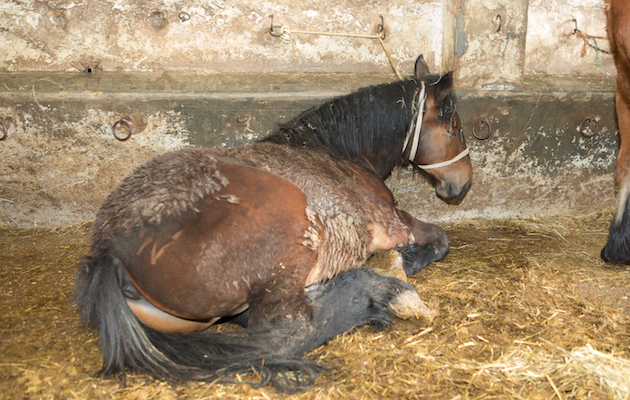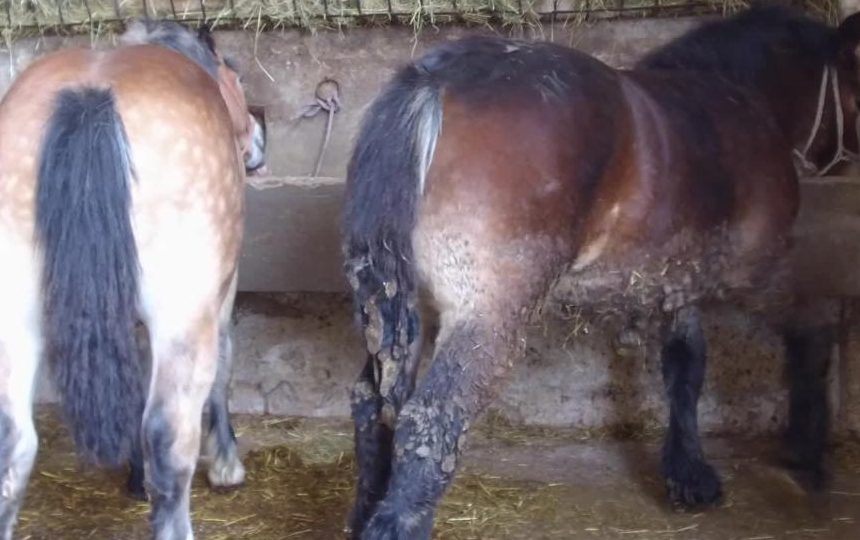The European Commission has announced plans to revise animal welfare legislation, including transport and the slaughter of animals, to “align it with the latest scientific evidence, broaden its scope, make it easier to enforce and ultimately ensure a higher level of animal welfare”. H&H finds out what this means in the decades-long fight against long-distance transport for slaughter
A REVIEW of European regulations on the transport of horses and other animals for slaughter has been described as a “once in a generation” opportunity.
The European Commission has set out plans to review the regulations as part of its Farm to Fork Strategy, under the European Green Deal. The aim of the strategy is to create a healthier and more sustainable EU food system.
{"content":"PHA+VGhlIGNvbW1pc3Npb24gc3RhdGVkIHRoYXQgYmV0dGVyIGFuaW1hbCB3ZWxmYXJlIGltcHJvdmVzIGFuaW1hbCBoZWFsdGggYW5kIGZvb2QgcXVhbGl0eSwgcmVkdWNlcyB0aGUgbmVlZCBmb3IgbWVkaWNhdGlvbiBhbmQgaGVscHMgcHJlc2VydmUgYmlvZGl2ZXJzaXR5LjwvcD4KPHA+4oCcVGhlIGNvbW1pc3Npb24gd2lsbCByZXZpc2UgdGhlIGFuaW1hbCB3ZWxmYXJlIGxlZ2lzbGF0aW9uLCBpbmNsdWRpbmcgdHJhbnNwb3J0IGFuZCB0aGUgc2xhdWdodGVyIG9mIGFuaW1hbHMsIHRvIGFsaWduIGl0IHdpdGggdGhlIGxhdGVzdCBzY2llbnRpZmljIGV2aWRlbmNlLCBicm9hZGVuIGl0cyBzY29wZSwgbWFrZSBpdCBlYXNpZXIgdG8gZW5mb3JjZSBhbmQgdWx0aW1hdGVseSBlbnN1cmUgYSBoaWdoZXIgbGV2ZWwgb2YgYW5pbWFsIHdlbGZhcmUs4oCdIHNhaWQgYSBzcG9rZXNtYW4uPC9wPgo8cD48YSBocmVmPSJodHRwczovL3d3dy5ob3JzZWFuZGhvdW5kLmNvLnVrL3RhZy93b3JsZC1ob3JzZS13ZWxmYXJlIj5Xb3JsZCBIb3JzZSBXZWxmYXJlPC9hPiBjaGllZiBleGVjdXRpdmUgUm9seSBPd2VycyB0b2xkIDxlbT5IJmFtcDtIPC9lbT4gdGhlIGNoYXJpdHkgaXMg4oCcZGVsaWdodGVk4oCdIGFib3V0IHRoZSByZXZpZXcuIFdvcmxkIEhvcnNlIFdlbGZhcmUgaXMgaW4gY29udGFjdCB3aXRoIHRoZSBFdXJvcGVhbiBGb29kIFNhZmV0eSBBdXRob3JpdHkgYW5kIHdpbGwgYmUgcHJvdmlkaW5nIGV2aWRlbmNlIHRvIHRoZSBjb21taXNzaW9uLCB3aXRoIGEgbWVldGluZyBzY2hlZHVsZWQgdGhpcyBtb250aCwgYXMgd2VsbCBhcyBwcm92aWRpbmcgZXZpZGVuY2UgdG8gdGhlIEV1cm9wZWFuIFBhcmxpYW1lbnQgYW5kIG90aGVyIHN0YWtlaG9sZGVycy48L3A+CjxwPjxkaXYgY2xhc3M9ImFkLWNvbnRhaW5lciBhZC1jb250YWluZXItLW1vYmlsZSI+PGRpdiBpZD0icG9zdC1pbmxpbmUtMiIgY2xhc3M9ImlwYy1hZHZlcnQiPjwvZGl2PjwvZGl2PjxzZWN0aW9uIGlkPSJlbWJlZF9jb2RlLTMxIiBjbGFzcz0iaGlkZGVuLW1kIGhpZGRlbi1sZyBzLWNvbnRhaW5lciBzdGlja3ktYW5jaG9yIGhpZGUtd2lkZ2V0LXRpdGxlIHdpZGdldF9lbWJlZF9jb2RlIHByZW1pdW1faW5saW5lXzIiPjxzZWN0aW9uIGNsYXNzPSJzLWNvbnRhaW5lciBsaXN0aW5nLS1zaW5nbGUgbGlzdGluZy0tc2luZ2xlLXNoYXJldGhyb3VnaCBpbWFnZS1hc3BlY3QtbGFuZHNjYXBlIGRlZmF1bHQgc2hhcmV0aHJvdWdoLWFkIHNoYXJldGhyb3VnaC1hZC1oaWRkZW4iPg0KICA8ZGl2IGNsYXNzPSJzLWNvbnRhaW5lcl9faW5uZXIiPg0KICAgIDx1bD4NCiAgICAgIDxsaSBpZD0ibmF0aXZlLWNvbnRlbnQtbW9iaWxlIiBjbGFzcz0ibGlzdGluZy1pdGVtIj4NCiAgICAgIDwvbGk+DQogICAgPC91bD4NCiAgPC9kaXY+DQo8L3NlY3Rpb24+PC9zZWN0aW9uPjwvcD4KPHA+VGhlIGNoYXJpdHksIHdoaWNoIGhhcyBiZWVuIGNhbXBhaWduaW5nIGZvciBhbiBlbmQgdG8gbG9uZy1kaXN0YW5jZSB0cmFuc3BvcnQgb2YgaG9yc2VzIGZvciBzbGF1Z2h0ZXIgZm9yIGRlY2FkZXMsIGlzIGFsc28gdW5kZXJ0YWtpbmcgcmVzZWFyY2ggd2l0aCB0aGUgVW5pdmVyc2l0eSBvZiBCb2xvZ25hIG9uIHRoZSBpbXBhY3Qgb2Ygam91cm5leSB0aW1lcyBvbiB3ZWxmYXJlLjwvcD4KPHA+4oCcVGhlIGNoYWxsZW5nZSB3aXRoIGN1cnJlbnQgbGVnaXNsYXRpb24gaXMgd2hpbGUgaXQgZG9lcyBkZWZpbmUgc3BlY2lmaWMgcmVxdWlyZW1lbnRzIGZvciBlcXVpbmVzIHRvIHNvbWUgZGVncmVlLCB0aGUgd2VsZmFyZSBpbXBhY3RzIG9mIHRyYW5zcG9ydCBhcmUgdmVyeSBjb21wbGV4IGFuZCB0aGVyZWZvcmUgd2UgbmVlZCByZWd1bGF0aW9ucyB0YWlsb3JlZCBzcGVjaWZpY2FsbHkgZm9yIGVxdWluZXMs4oCdIHNhaWQgTXIgT3dlcnMuPC9wPgo8cD7igJxXZSBrbm93IGFyb3VuZCA0MiUgb2YgbGl2ZSB0cmFuc3BvcnQgb2YgZXF1aW5lcyBhY3Jvc3MgRVUgbWVtYmVyIHN0YXRlcyBhcmUgaW50ZW5kZWQgZm9yIHNsYXVnaHRlciDigJMgaXTigJlzIGEgc2lnbmlmaWNhbnQgcGFydCBzbyBpdOKAmXMgcmVhbGx5IGltcG9ydGFudCBsZWdpc2xhdGlvbiB0byBnZXQgcmlnaHQu4oCdPC9wPgo8ZGl2IGNsYXNzPSJhZC1jb250YWluZXIgYWQtY29udGFpbmVyLS1tb2JpbGUiPjxkaXYgaWQ9InBvc3QtaW5saW5lLTMiIGNsYXNzPSJpcGMtYWR2ZXJ0Ij48L2Rpdj48L2Rpdj4KPHA+VGhlIGNoYXJpdHkgaXMgY2FsbGluZyBmb3IgYSBuaW5lLSB0byAxMi1ob3VyIGZpbml0ZSBqb3VybmV5IGxpbWl0LCBtb3JlIHNwYWNlIGFsbG93YW5jZSwgYW5kIGJldHRlciB0cmFpbmluZyBhbmQgY29tcGV0ZW5jZSBvZiBkcml2ZXJzIGFuZCBlcXVpbmUgaGFuZGxlcnMuPC9wPgo8cD7igJxUaGUgZXhpc3RpbmcgcmVndWxhdGlvbiBhbGxvd3Mgam91cm5leXMgdXAgdG8gMjQgaG91cnMsIHRoZW4gYSAyNC1ob3VyIHJlc3QsIHRoZW4gYW5vdGhlciAyNCBob3Vyc+KAmSBqb3VybmV5IOKAkyB5b3UgY291bGQgYmUgZ29pbmcgdGhyb3VnaCBtYW55IGRpZmZlcmVudCBjb3VudHJpZXMgYW5kIHRoYXQgam91cm5leSBjYW4gbGFzdCBhbiBldGVybmFsIHRpbWUs4oCdIE1yIE93ZXJzIHNhaWQuIOKAnEEgbmluZS0gdG8gMTItaG91ciBsaW1pdCBpcyBiYXNlZCBpbiBwYXJ0IG9uIHNjaWVudGlmaWMgZXZpZGVuY2UsIGJ1dCBhbHNvIGhhcm1vbmlzZXMgd2VsbCB3aXRoIGRyaXZlciBob3VycyBsZWdpc2xhdGlvbi4gVGhpcyBtYWtlcyBpdCBtb3JlIGVuZm9yY2VhYmxlIGFuZCBlYXNpZXIgdG8gY29tcGx5IHdpdGgu4oCdPC9wPgo8ZGl2IGNsYXNzPSJhZC1jb250YWluZXIgYWQtY29udGFpbmVyLS1tb2JpbGUiPjxkaXYgaWQ9InBvc3QtaW5saW5lLTQiIGNsYXNzPSJpcGMtYWR2ZXJ0Ij48L2Rpdj48L2Rpdj4KPHA+4oCcV2UgYWxzbyBrbm93IG9uZSBvZiB0aGUgbW9zdCBzdHJlc3NmdWwgdGltZXMgb2YgdGhlIGpvdXJuZXkgaXMgdGhlIGxvYWRpbmcgYW5kIHVubG9hZGluZyBzbyBlcXVpbmUgaGFuZGxpbmcgaXMgcmVhbGx5IGltcG9ydGFudC7igJ08L3A+CjxwPk1yIE93ZXJzIHNhaWQgdGhlIGNoYXJpdHksIHdoaWNoIGlzIGEgbWVtYmVyIG9mIHRoZSBFdXJvZ3JvdXAgZm9yIEFuaW1hbHMgYWxvbmcgd2l0aCBvdGhlciBmYXJtIGFuaW1hbCBjaGFyaXRpZXMgYW5kIHRoZSBEb25rZXkgU2FuY3R1YXJ5IHdvcmtpbmcgb24gdGhlIHJldmlldywgaGFzIGEgbWVldGluZyB3aXRoIHRoZSBFdXJvcGVhbiBDb21taXNzaW9uIGF0IHRoZSBlbmQgb2YgdGhlIG1vbnRoLCBhbmQgaXQgaXMgaG9wZWQgbmV3IGxlZ2lzbGF0aW9uIGNvdWxkIGFycml2ZSBpbiAyMDIzLjwvcD4KPGRpdiBjbGFzcz0iYWQtY29udGFpbmVyIGFkLWNvbnRhaW5lci0tbW9iaWxlIj48ZGl2IGlkPSJwb3N0LWlubGluZS01IiBjbGFzcz0iaXBjLWFkdmVydCI+PC9kaXY+PC9kaXY+CjxwPuKAnFdlIG5lZWQgdG8gYmUgbG9iYnlpbmcgdmVyeSBlZmZlY3RpdmVseSB0aGlzIHllYXIgYmVjYXVzZSB0aGUgZHJhZnQgbGVnaXNsYXRpb24gd2lsbCBzdGFydCB0byBldm9sdmUgaW4gMjAyMi4gVGhlIEVVIGlzIGZvY3VzaW5nIHNwZWNpZmljYWxseSBvbiBhbmltYWxzIGZvciBzbGF1Z2h0ZXIgc28gaXTigJlzIGEgdmVyeSBkaXN0aW5jdCBlbGVtZW50IOKAkyBpdCB3b27igJl0IGltcGFjdCBvbiBhbmltYWxzIHVzZWQgaW4gc3BvcnQuIEl0IGlzIGZvY3VzZWQgd2hpY2ggaXMgYSBnb29kIHRoaW5nLCBidXQgdGhlIGNvbXBsZXhpdHkgb2YgdGhlIGFyZWEgbWFrZXMgaXQgYSBjaGFsbGVuZ2Us4oCcIGhlIHNhaWQuPC9wPgo8cD7igJxVbmRlcnRha2luZyB0aGUgcmV2aWV3IGlzIG9uZSB0aGluZywgZ2V0dGluZyBsZWdpc2xhdGlvbiB0aGF0IHJlZmxlY3RzIHNjaWVudGlmaWMgZXZpZGVuY2UgYnV0IGlzIGFsc28gZmxleGlibGUgZW5vdWdoIHRvIGJlIGFkYXB0ZWQgd2hlbiBuZXcgc2NpZW50aWZpYyBldmlkZW5jZSBiZWNvbWVzIGF2YWlsYWJsZSwgd2lsbCB0YWtlIGEgYml0IG9mIHRpbWUu4oCdPC9wPgo8cD5NciBPd2VycyBkZXNjcmliZWQgdGhlIHJldmlldyBhcyBhIOKAnG9uY2UgaW4gYSBnZW5lcmF0aW9u4oCdIG9wcG9ydHVuaXR5LjwvcD4KPHA+4oCcT3VyIGN1cnJlbnQgc3RyYXRlZ3kgaXMgdG8gZW5kIHRoZSBsb25nLWRpc3RhbmNlIHRyYW5zcG9ydCBvZiBob3JzZXMgdG8gc2xhdWdodGVyIGFjcm9zcyBFdXJvcGUgYnkgb3VyIGNlbnRlbmFyeSAyMDI3LCBhbmQgd2UgdGhpbmsgdGhpcyByZXZpZXcgbWVhbnMgdGhhdCB0aGF0IGdvYWwgaGFzIG5ldmVyIGJlZW4gbW9yZSBhdHRhaW5hYmxlLiBXZSBhcmUgYWJzb2x1dGVseSBmb2N1c2VkIG9uIHRoYXQu4oCdPC9wPgo8cD5BIHNwb2tlc21hbiBmb3IgdGhlIDxhIGhyZWY9Imh0dHBzOi8vd3d3LmhvcnNlYW5kaG91bmQuY28udWsvdGFnL3RoZS1kb25rZXktc2FuY3R1YXJ5Ij5Eb25rZXkgU2FuY3R1YXJ5PC9hPiB0b2xkPGVtPiBIJmFtcDtIPC9lbT4gdGhlIGNoYXJpdHkgaGFzIGJlZW4gcHJvdmlkaW5nIGluZm9ybWF0aW9uIGRpcmVjdGx5IGludG8gdGhlIHJldmlldyBhcyBhIG1lbWJlciBvZiB0aGUgRXVyb2dyb3VwIGZvciBBbmltYWxzLjwvcD4KPGRpdiBjbGFzcz0iaW5qZWN0aW9uIj48L2Rpdj4KPHA+4oCcV2Ugd291bGQgbGlrZSB0byBzZWUgY2hhbmdlcyBpbXBsZW1lbnRlZCB0aGF0IHdvdWxkIGFsbG93IGJldHRlciBlbmZvcmNlbWVudCBvZiB0aGUgcmVndWxhdGlvbnMsIGFzIHdlbGwgYXMgYSBtYXhpbXVtIGpvdXJuZXkgdGltZSBmb3IgZXF1aW5lcyzigJ0gaGUgc2FpZC48L3A+CjxwPuKAnEFsbCBlcXVpbmVzIHNob3VsZCBiZSB0cmFuc3BvcnRlZCBpbiBhbiBhcHByb3ByaWF0ZSBlbnZpcm9ubWVudCwgYWxsb3dpbmcgZm9yIHRpbWUgdG8gcmVzdCwgZmVlZCwgd2F0ZXIgYW5kIHJlY292ZXIgZnJvbSB0aGUgc3RyZXNzZXMgb2YgbG9uZyBkaXN0YW5jZSB0cmF2ZWwuIERvbmtleXMgYW5kIG11bGVzIHNob3VsZCBhbHdheXMgYmUgdHJhbnNwb3J0ZWQgdW5kZXIgY29uZGl0aW9ucyB0aGF0IGFyZSBzdWl0YWJsZSB0byB0aGVpciBzcGVjaWZpYyBuZWVkcy7igJ08L3A+CjxwPgo="}
You might also be interested in…
Read the last of three blogs about H&H's journey across Europe with World Horse Welfare
World Horse Welfare is urging horse-lovers to sign a petition to end the long-distance transport of horses for slaughter, before
Library image.
Credit: Lucy Merrell
‘I urge everyone to sign so together we can complete the job of ending the long-distance transport of horses to
Every signature counts in World Horse Welfare's campaign to bring an end to these 'completely unnecessary journeys that still cause
Library image
A Defra webinar on 4 November explained in detail the steps anyone taking horses from Britain to EU member states
Stay in touch with all the news in the run-up to and throughout the major shows and events during 2025 and beyond with a Horse & Hound subscription. Subscribe today for all you need to know ahead of these major events, plus online reports on the action as it happens from our expert team of reporters and in-depth analysis in our special commemorative magazines. Have a subscription already? Set up your unlimited website access now
H&H senior news writer
Since joining H&H in 2018, Becky has covered a broad range of equestrian news including welfare matters, veterinary studies, FEI Tribunal hearings and road safety campaigns. She has also interviewed top riders including Scott Brash, John Whitaker and Ian Stark, to name just a few. Becky’s reporting has taken her to Canada for Spruce Meadows and France for Pau five-star, as well as the Royal Highland and Blair Castle International Horse Trials closer to home. She was also a key part of the remote reporting team for the Tokyo Olympics and the Europeans.







